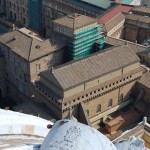Sistine Chapel Vatican
Sistine Chapel (Italian: Cappella Sistina) in Vatican, a former home church. Built in 1473-1481 by architect George de Dolci on Pope Sixtus IV’s order; thus, the origin of its name.
Under Pope Sixtus IV, significant reconstructions of the Vatican Palace were undertaken; at the same time the world-wide famous Sistine Chapel was built — the greatest monument of painting art of the Renaissance epoch. Construction of the chapel as well as overseeing over fulfillment of its wall paintings dedicated to plots from the Old and New Testaments was commissioned to a Florence architect G. Dolce. The idea to build the chapel was conceived by Sixtus IV, predecessor of Pope Nicholas V.
Sixtus IV wanted to see a building that would present in the eyes of Catholics of the entire world a stronghold of the Church, while by its decoration would emphasize the might of the Church. Since the very beginning of its foundation and until recent time conclaves for election of the new Pope gathered in it.
Getting along with the Pope’s will the architects made the chapel outwardly look like a bastion. However, inside the chapel regardless of its relatively small size had a magnificent appearance thanks to the efforts of the best artists and decorators of the time. The chapel’s square hall is divided by marble grates into two parts; the side walls of the hall have windows, in which the early Popes are portrayed in full stature.
The lower part of the side walls is decorated by cloth-like ornaments, while the middle level is full of murals from the history of the Old and New Testaments. Such famous artists as Bernardino Pintoricchio and Pietro Perugino, Sandro Botticelli and Domenico Ghirlandaio, Kosmo Rosseli took place in painting and decorating of the Sistine Chapel, while the plafond of the chapel was painted by Great Michelangelo.
Throughout the entire length of the chapel’s side walls there are twelve square frescoes. The altar wall was painted by Perugino’s frescoes on themes “The Finding of Moses” and “The Birth of Christ” but they are preserved to us only in descriptions. Later, on an order of one of the Popes these frescoes were beaten down, and on the wall from floor to ceiling one of the most tremendous pieces of art of monumental painting was created — Michelangelo’s famous “Last Judgment.”
In 1508, Pope Julius II commissioned Michelangelo to paint the ceiling of the Sistine Chapel. Michelangelo by that time was already famous as an outstanding sculptor and in all possible ways tried to escape the painting proposing to commission this job to Rafael. But the Pope was unyielding, and the artist did not dare to refuse.
In August of 1508, Michelangelo ascended the scaffolds purposely built for his painting, but his thoughts were still full of nude sculptural images he had to cut for the Papal tomb in the Saint Peter’s Cathedral. On Pope Julius II’s order works on the tomb were stopped, and Michelangelo seriously worried about that. But he gained the Pope’s permission to paint on the ceiling whatever his unrestrained fantasy told him: he decided to decorate the entire ceiling with frescoes on Biblical themes.
Pages: 1 2

